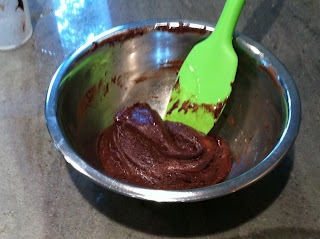Kat of The Bobwhites was our August 2012 Daring Baker hostess who inspired us to have fun in creating pate a choux shapes, filled with crème patisserie or Chantilly cream. We were encouraged to create swans or any shape we wanted and to go crazy with filling flavors allowing our creativity to go wild!
Pate a choux is one of my favorite things to make in the pastry world. The textures of the "in progress" dough/batter is pretty cool. First, when you add the flour to the hot butter/water/salt combo, the mass gets sticky and pulls away from the edges of the bowl. It's neat.
 But, the really, really, really cool part is when you add the eggs in, they and the batter slide into pieces and slip around each other in the bowl until - - POW - - it comes together.
But, the really, really, really cool part is when you add the eggs in, they and the batter slide into pieces and slip around each other in the bowl until - - POW - - it comes together.Pate a choux
Ingredients½ cup (120 ml) (115 gm) (4 oz) butter
1 cup (240 ml) water
¼ teaspoon (1½ gm) salt
1 cup (240 ml) (140 gm) (5 oz) all-purpose flour
4 large eggs
Directions:
- Line two baking sheets with silicone mats or parchment paper, or grease pans well.
- Preheat oven to 375°F/190°C/gas mark 5.
- In a small pot, combine butter, water, and salt. Heat until butter melts, then remove from stove.
- Add flour all at once and beat, beat, beat the mixture until the dough pulls away from the sides of the pot.
- Add one egg, and beat until well combined. Add remaining eggs individually, beating vigorously after each addition. Resulting mixture should be somewhat glossy, very smooth, and somewhat thick.
- Using a ¼” (6 mm) tip on a pastry bag, pipe out about 30-36 swan heads. You’re aiming for something between a numeral 2 and a question mark, with a little beak if you’re skilled and/or lucky.
- Remove the tip from the bag and pipe out 36 swan bodies. These will be about 1.5” (40 mm) long, and about 1” (25 mm) wide. One end should be a bit narrower than the other.
- Bake the heads and bodies until golden and puffy. The heads will be done a few minutes before the bodies, so keep a close eye on the baking process.
- Remove the pastries to a cooling rack, and let cool completely before filling.
Vanilla Pastry Cream
Ingredients:1 cup (225 ml.) whole milk
2 Tbsp. cornstarch
6 Tbsp. (100 g.) sugar
1 large egg
2 large egg yolks
2 Tbsp. (30 g.) unsalted butter
1 Tsp. Vanilla
Directions:
- Dissolve cornstarch in ¼ cup of milk. Combine the remaining milk with the sugar in a saucepan; bring to boil; remove from heat.
- Beat the whole egg, then the yolks into the cornstarch mixture. Pour 1/3 of boiling milk into the egg mixture, whisking constantly so that the eggs do not begin to cook.
- Return the remaining milk to boil. Pour in the hot egg mixture in a stream, continuing whisking.
- Continue whisking until the cream thickens and comes to a boil. Remove from heat and beat in the butter and vanilla.
- Pour cream into a bowl. Press plastic wrap firmly against the surface. Chill immediately and until ready to use.
- Take a swan body and use a very sharp knife to cut off the top half.
- Cut the removed top down the center to make two wings.
- Dollop a bit of filling into the body, insert head, and then add wings.



















.JPG)
.JPG)







.JPG)











